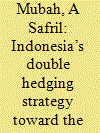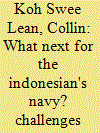| Srl | Item |
| 1 |
ID:
170628


|
|
|
|
|
| Summary/Abstract |
This study highlights Indonesia’s strategy in response to the growing competition between the United States and China. In recent years, Indonesia under the administration of President Joko Widodo has played a strategic role in maintaining regional stability in the Indo-Pacific amid inflaming tensions between the two countries. On the basis of an “independent and active” foreign policy with Association of Southeast Asian Nations (ASEAN) at the center of a concentric circle, Indonesia has employed a hedging strategy to bolster regional stability and foster cooperation among countries in the region. While there may be room for a hedging strategy, it is important to understand how Indonesia has employed this strategy to shape the regional order. This paper argues that Indonesia has adopted a double hedging strategy of economic pragmatism on the one hand and limited bandwagoning on the other. The former includes a deepening of economic cooperation with China through collaboration between Indonesia’s vision of a Global Maritime Fulcrum and China’s Belt and Road Initiative. The latter includes keeping the US involved in the Indo-Pacific by proposing its Indo-Pacific concept to regional players without challenging the existing proposals offered by major powers. This paper consists of four sections. The first section introduces the theoretical basis by focusing on Indonesia’s foreign policy ideas as it deals with competition between great powers. The second section discusses the synthesis of Indonesia’s vision of a Global Maritime Fulcrum and concept of the Indo-Pacific. The third section demonstrates how Indonesia has employed its double hedging strategy. The fourth section highlights the conclusions of this study by summarizing Indonesia’s response to competition between the US and China and providing recommendations for further research.
|
|
|
|
|
|
|
|
|
|
|
|
|
|
|
|
| 2 |
ID:
150588


|
|
|
|
|
| Summary/Abstract |
Indonesia's geo-strategic position, its huge archipelagic disposition and its large population, which accounts for close to two-fifths of Southeast Asia's total population, can be said to possesses some natural characteristics needed for emerging as a maritime power. Maritime consciousness has always been possessed by Indonesia and many initiatives have been undertaken by the previous leaderships to cater to its maritime interests, but these initiatives have not been able to place Indonesia in the category of a maritime power. The current president has for the first time publicly promulgated his vision of making his country a maritime power. In this context, the study will aim to analyse Indonesia's potential as a maritime power by examining whether the measures undertaken by Jokowi and his predecessor, Yudhoyono, can help this vision in taking shape.
|
|
|
|
|
|
|
|
|
|
|
|
|
|
|
|
| 3 |
ID:
142083


|
|
|
|
|
| Summary/Abstract |
A greenwater navy ought to be effective within its country’s immediate waters, especially the exclusive economic zone (EEZ) while also possessing a limited extra-regional force projection ability. Based on this definition, the Indonesian Navy does not adequately perform this dual role. While President Joko “Jokowi” Widodo’s Global Maritime Fulcrum (GMF) vision gives the navy’s long-term greenwater ambitions greater traction, it still faces capacity-building constraints thus prompting it to adopt the Minimum Essential Force (MEF) blueprint as an interim measure. This article examines the Indonesian Navy’s prospects of attaining its MEF targets by 2024 as part of its long-term greenwater naval ambitions commensurate with Indonesia’s “maritime medium-ness”. To identify these capacity gaps, this article models the navy’s MEF projections based on three scenarios: Standard, Optimistic and Austere. Results show that under an Austere Scenario, the navy cannot possibly achieve its MEF targets across all categories by 2024. The Optimistic and Standard Scenarios are more realistic. Gaps in certain categories, primarily the PKR-10514 light frigate programme which forms a key facet of the navy’s greenwater aspirations, are identified. But the risks of project overruns and budget challenges may militate against the modest projections derived in this study. Therefore, this article proposes a recalibration of the MEF specifications, by reducing the number of high-capability PKR-10514s optimized for warfighting in exchange for a larger force of low-capability “PKR-minus” optimized for EEZ duties.
|
|
|
|
|
|
|
|
|
|
|
|
|
|
|
|